Soccer

Soccer Misconduct (Foul)
Fouls and misconduct in football/soccer are acts committed by players which are deemed by the referee to be unfair and are subsequently penalized. An offense may be a foul, misconduct or both depending on the nature of the offense and the circumstances in which it occurs. Fouls and misconduct are addressed in Law 12 of the Laws of the Game.
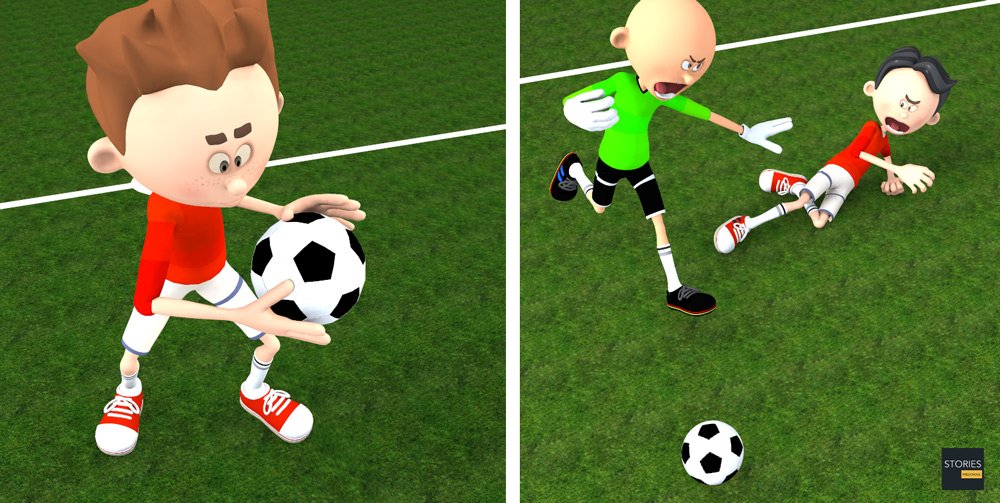
A foul is an unfair act by a player, deemed by the referee to contravene the game's laws, that interferes with the active play of the game. Fouls are punished by the award of a free kick (direct or indirect depending on the offense) or penalty kick to the opposing team. A list of specific offenses that can be fouls are detailed in Law 12 of the Laws of the Game (other infractions, such as technical infractions at restarts, are not deemed to be fouls), these mostly concern unnecessarily aggressive physical play and the offense of handling the ball. Additionally, a foul can only be committed by a player (not a substitute) and on the field of play, while the ball is in play. Where applicable, fouls are limited to acts committed against an opponent (for example, a player striking the referee or a teammate is not a foul, but is misconduct).
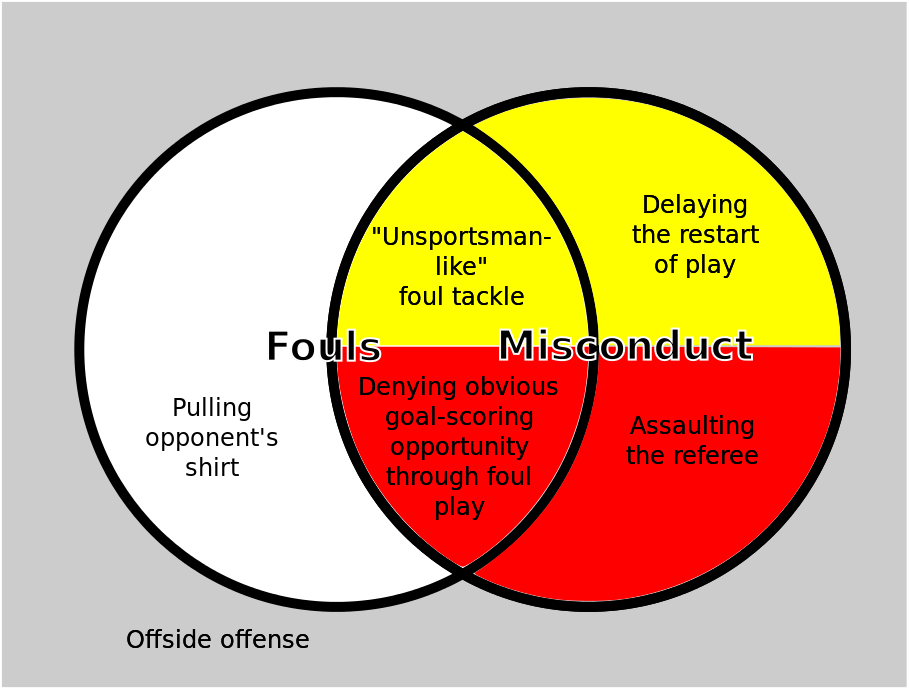
Misconduct is any conduct by a player that is deemed by the referee to warrant a disciplinary sanction (caution or dismissal). Misconduct may include acts which are, additionally, fouls. Misconduct may occur at any time, including when the ball is out of play, during half-time and before and after the game, and both players and substitutes may be sanctioned for misconduct. This is unlike a foul, which is committed by a player, on the field of play, and only against an opponent when the ball is in play.
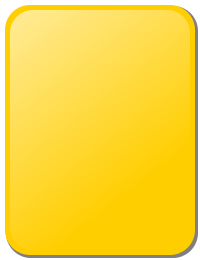
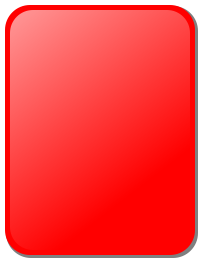
Misconduct will result in the player either receiving a caution (indicated by a yellow card) or being dismissed ("sent off") from the field (indicated by a red card). A dismissed player cannot be replaced; their team is required to play the remainder of the game with one fewer player. When a player is cautioned, the player's details are traditionally recorded by the referee in a small notebook; hence, a caution is also known as a "booking". A second caution results in the player being dismissed. The referee has considerable discretion in applying the Laws; in particular, the offense of "unsporting behaviour" may be used to deal with most events that violate the spirit of the game, even if they are not listed as specific offenses.
The system of cautioning and dismissal has existed for many decades, but the idea of language-neutral coloured cards originated with English referee Ken Aston, who got the idea while sitting in his car at a traffic light. The first major use of the cards was in the 1970 FIFA World Cup, but they were not made mandatory at all levels until 1992. Association football was the first major sport to use penalty cards; the practice has since been adopted by many other sports.
Categories of Foul
Direct Free Kick Offenses
A direct free kick is awarded when a player commits any of the following in a manner considered by the referee to be careless, reckless or using excessive force:
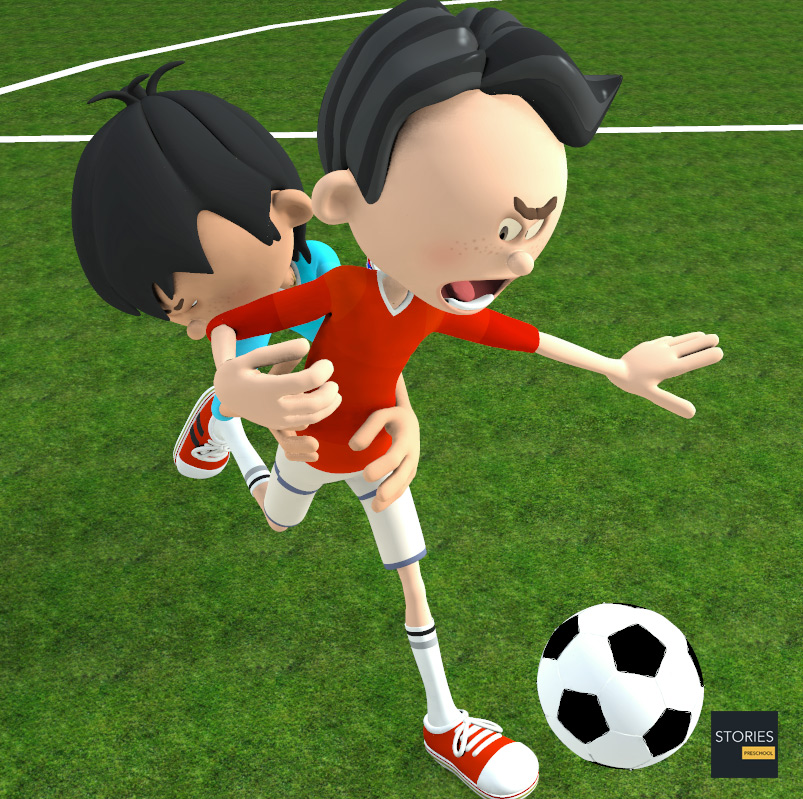
- Kicks or attempts to kick an opponent
- Trips or attempts to trip an opponent
- Jumps at an opponent
- Charges an opponent
- Strikes or attempts to strike an opponent
- Pushes an opponent
- Tackles an opponent
Or commits any the following offenses:
- Holds an opponent
- Spits at an opponent
- Handles the ball deliberately (except for the goalkeeper within his own penalty area).
In determining whether or not a player deliberately handled the ball, the referee has several considerations:
- Movement of the hand towards the ball (not the ball towards the hand)
- Distance between the opponent and the ball (unexpected ball)
- Position of the hand ('natural' position versus 'unnatural' position) does not necessarily mean that there is an infringement
- Touching the ball with an object held in the hand (clothing, shinguard, etc.) counts as an infringement (considered an extension of the hand)
- Hitting the ball with a thrown object (boot, shinguard, etc.) counts as an infringement (also considered an extension of the hand)
If a player commits a direct free kick offense within his own penalty area, a penalty kick is awarded irrespective of the position of the ball, provided the ball is in play.
Indirect Free Kick Offenses
Fouls punishable by an indirect free kick are:
- When a goalkeeper, inside his own penalty area:
- controls the ball with his hands for more than six seconds before releasing it from his possession
- touches the ball again with his hands after he has released it from his possession and before it has touched another player
- touches the ball with his hands after it has been deliberately kicked to him by a team-mate (the back-pass rule)
- touches the ball with his hands after he has received it directly from a throw-in taken by a team-mate
- When any player in the opinion of the referee:
- plays in a dangerous manner
- impedes the progress of an opponent
- prevents the goalkeeper from releasing the ball from his hands
- commits any other offense, not previously mentioned in Law 12, for which play is stopped to caution or send off a player
Some technical breaches of the rules, such as the offside offense, result in play being restarted with an indirect free kick, though these are not considered fouls.
Other Offenses
Not all infractions of the Laws are fouls. Non-foul infractions may be dealt with as technical infractions (e.g. as breaching the rules governing the restarts of play) or misconduct (these are punishable by a caution or sending-off). Note that persistent infringement of the Laws is an offense for which the player may be cautioned.
Misconduct
The referee may consider serious and/or persistent offenses to be misconduct worthy of an official caution or dismissal from the game. Association football was the first sport to use coloured cards to indicate these actions.
Yellow Card (caution)

A yellow card is shown by the referee to indicate that a player has been officially cautioned. The player's details are then recorded by the referee in a small notebook; hence a caution is also known as a "booking". A player who has been cautioned may continue playing in the game; however, a player who receives a second caution in a match is sent off (shown the yellow card again, and then a red card). Law 12 of the Laws of the Game (which are set by the International Football Association Board and used by FIFA) lists the types of offenses and misconduct that may result in a caution. It also states that "only a player, substitute or substituted player" can be cautioned. A player is cautioned and shown a yellow card if he/she commits any of the following offenses:
- Unsporting behaviour
- Dissent by word or action
- Persistent infringement of the Laws of the Game
- Delaying the restart of play
- Failure to respect the required distance when play is restarted with a corner kick, throw-in or free kick
- Entering or re-entering the field of play without the referee's permission
- Deliberately leaving the field of play without the referee's permission
What constitutes cautionable unsporting behaviour is generally at the referee's discretion, though the Interpretation and Guidelines which accompany the Laws list a number of examples. These include simulation intended to deceive the referee, or attempting to score by handling the ball. Fouls which are committed recklessly or fouls which are committed with the intention of breaking up a promising attack are also considered unsporting behaviour and punishable with a yellow card. Fouls which are committed with excessive force, however, or which deny an obvious goalscoring opportunity for the player fouled (i.e. a professional foul), are punishable by a red card.
A change in 2004 to the Laws of the Game championed by FIFA President Sepp Blatter mandated automatic yellow cards for players who remove their shirts while celebrating goals, as he considered this to be unsporting behaviour. In addition, an instruction has been in the additional instructions at the end of the Laws of the Game for some time that should a player jump over or climb onto a perimeter fence to the field of play, he or she should be cautioned for unsporting behaviour. This was seen as mainly preventing incidents in professional football matches where crowds had rushed towards players and had led to injuries.
In most tournaments, the accumulation of a certain number of yellow cards over several matches results in disqualification of the offending player for a certain number of subsequent matches, the exact number of cards and matches varying by jurisdiction. In the UEFA Champions League, for instance, accumulating two yellow cards in a stage of the tournament will lead to a one-game suspension. In such situations players have often been suspected (and occasionally even admitted) to deliberately incur a second booking in a tournament when the following game is of little importance, deliberately resetting their yellow card tally to zero for subsequent games (known as "cleaning cards"). However, while technically within the laws of the game, this is considered unsportsmanlike conduct, and UEFA has launched an investigation resulting in fines or suspensions.
The idea introducing a sin-bin for yellow card offenses has been mooted by, amongst others, UEFA president Michel Platini.
Red Card (dismissal)

A red card is shown by a referee to signify that a player must be sent off. A player who has been sent off is required to leave the field of play immediately, must take no further part in the game and cannot be replaced by a substitute, forcing his team to play a man fewer. Only players, substitutes and substituted players may receive a red card. If a team's goalkeeper receives a red card another player is required to assume goalkeeping duties (teams usually substitute an outfield player for another goalkeeper if this option is available).
Law 12 of the Laws of the Game lists the categories of misconduct for which a player may be sent off. These are:
- Serious foul play
- Violent conduct
- Spitting at an opponent or any other person
- Denying the opposing team a goal or an obvious goalscoring opportunity by deliberately handling the ball (this does not apply to a goalkeeper within his own penalty area)
- Denying an obvious goalscoring opportunity to an opponent moving towards the player’s goal by an offense punishable by a free kick or a penalty kick
- Using offensive, insulting or abusive language and/or gestures
- Receiving a second caution in the same match
Serious foul play is a foul committed using excessive force (i.e., "the player...is in danger of injuring his opponent"). Violent conduct is distinct from serious foul play in that it may be committed by any player, substitute, or substituted player against any person, e.g., teammates, match officials, or spectators.
In most tournaments, a single direct red card (i.e. not one received as a result of two successive yellow ones) results in disqualification of the offending player for one or more subsequent matches, the exact number of matches varying by the offense committed and by jurisdiction. Should a team's on-field players receive a total of five red cards, they will be unable to field the required minimum of seven players and the match will be abandoned.
Referee's Discretion
The referee has a very large degree of discretion as to the interpretation of the 17 Laws including determining which acts constitute cautionable offenses under the very broad categories. For this reason, refereeing decisions are sometimes controversial. Some Laws may specify circumstances under which a caution should or must be given, and numerous directives to referees also provide additional guidance. The encouragement for referees to use their judgment and common sense is known colloquially as "Law 18".
Advantage
According to the principle of advantage, play should be allowed to continue when the team against which an offense has been committed will benefit from ongoing play. The referee indicates this by calling "play on!" or "advantage!" and extending both arms in front of his body.
FIFA's guidance on the interpretation of the Laws for referees outlines the considerations a referee must make when deciding whether to play advantage; these include the severity of the offense and the potential for attacking opportunity. Referees are instructed to make such decisions "within a few seconds" of the offense.
In rare situations, advantage can also be applied if the foul was also a misconduct. Play is allowed to continue, but at the next stoppage in play the caution or dismissal must be issued and the appropriate card displayed.
Restarts
If the ball is out of play when an infraction of the Laws of the Game occurs, play is restarted according to the reason the ball became out of play before the infraction. (Any infraction of the Laws of the Game that occurs while the ball is out of play can be misconduct, but is not a foul.)
If the misconduct occurs when the ball is in play, play need not be stopped to administer a caution or a dismissal, as these may be done at the next stoppage of play (this is usually the case when the opposing team would gain an advantage in having play continue). When this is the case, play is restarted according to the reason for the ball becoming out of play, e.g. a throw-in if play stopped due to the ball crossing a touchline.
If play is stopped to administer a caution or dismissal:
- If a foul has occurred as well as misconduct, play is restarted according to the nature of the foul (either an indirect free kick, direct free kick or penalty kick to the opposing team)
- If no foul under Law 12 has occurred, play is restarted with an indirect free kick to the opposing team
Team Officials
Team officials such as managers and coaches are not subject to the cautionable and sending-off offenses listed above, as these apply only to players, substitutes, and substituted players. However, according to Law 5 the referee "takes action against team officials who fail to conduct themselves in a responsible manner and may, at his discretion, expel them from the field of play and its immediate surroundings." No card would be displayed when taking such action.
The league sanction for a sent-off coach or manager is normally a ban from being in the dugout or in the changing room for a certain number of matches thereafter. The particular football association determines the length of the ban and/or other appropriate action(s).
Off-field
Along with the general administration of the sport, football associations and competition organizers also enforce good conduct in wider aspects of the game, dealing with issues such as comments to the press, clubs' financial management, doping, age fraud and match fixing. Most competitions enforce mandatory suspensions for players who are sent off in a game. Some on-field incidents, if considered very serious (such as allegations of racial abuse), may result in competitions deciding to impose heavier sanctions than those normally associated with a red card. Some associations allow for appeals against player suspensions incurred on-field if clubs feel a referee was incorrect or unduly harsh.
Sanctions for such infractions may be levied on individuals or on to clubs as a whole. Penalties may include fines, points deductions (in league competitions) or even expulsion from competitions. For example, the English and Scottish leagues will often deduct 10 points from a team that enters financial administration. Among other administrative sanctions are penalties against game forfeiture. Teams that had forfeited a game or had been forfeited against would be awarded a technical loss or win.
SPORTS

RESOURCES
This article uses material from the Wikipedia articles "Association football" and "Fouls and misconduct (association football)", which is released under the Creative Commons Attribution-Share-Alike License 3.0.
© Stories Preschool. All Rights Reserved.












